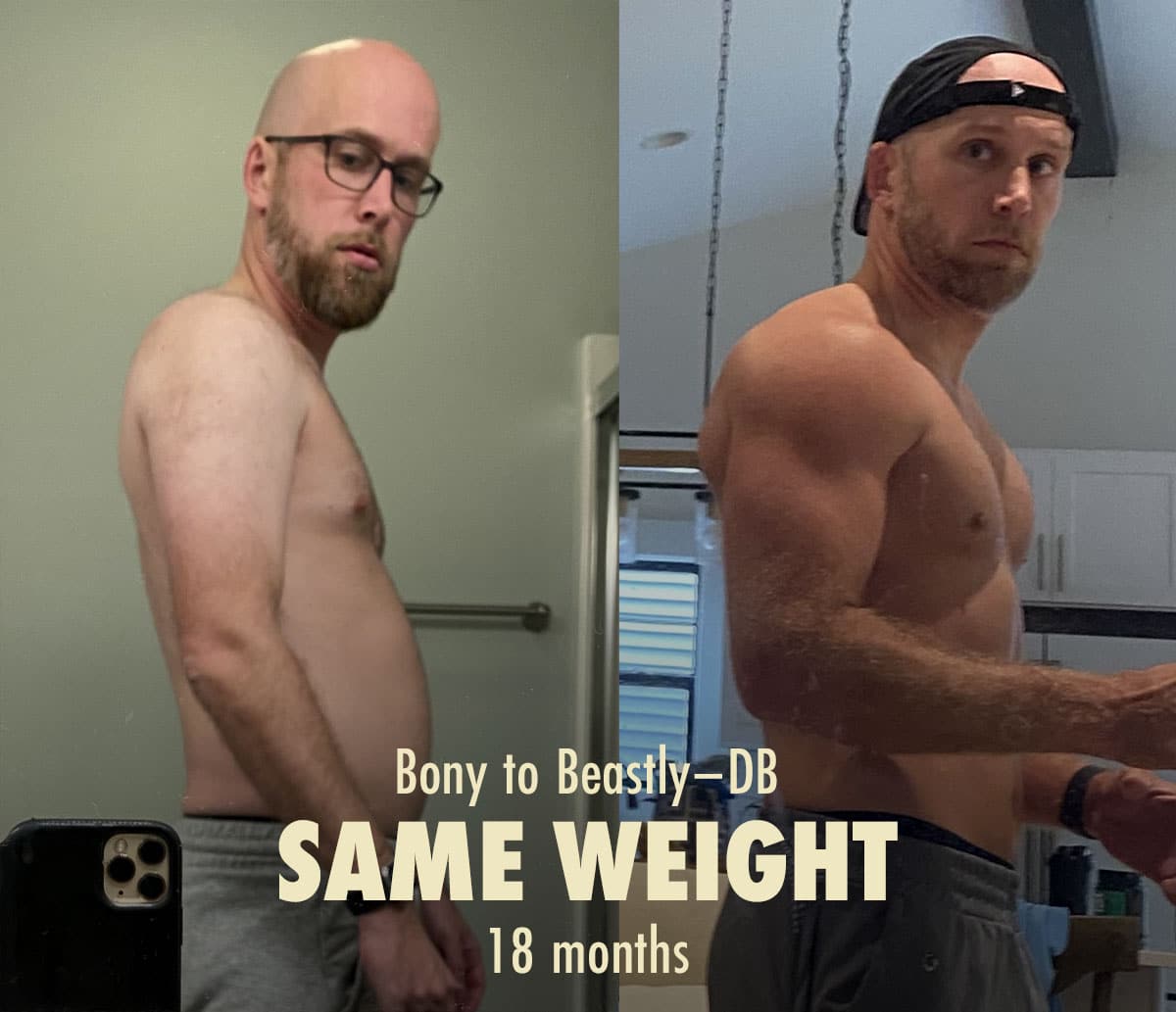
How Fast Can Skinny People Build Muscle?
I want to talk about how quickly skinny people can expect to build muscle. It’s a contentious topic. I’ve gained 70 pounds and spent the past decade helping over ten thousand skinny people bulk up, and I’ve noticed that most experts either get this wrong or forget to even mention us.
Most experts warn that gaining weight too quickly will make you fat, but they’re almost never talking about skinny people. When I ask them specifically about skinny people, their answer usually changes, sometimes quite dramatically.
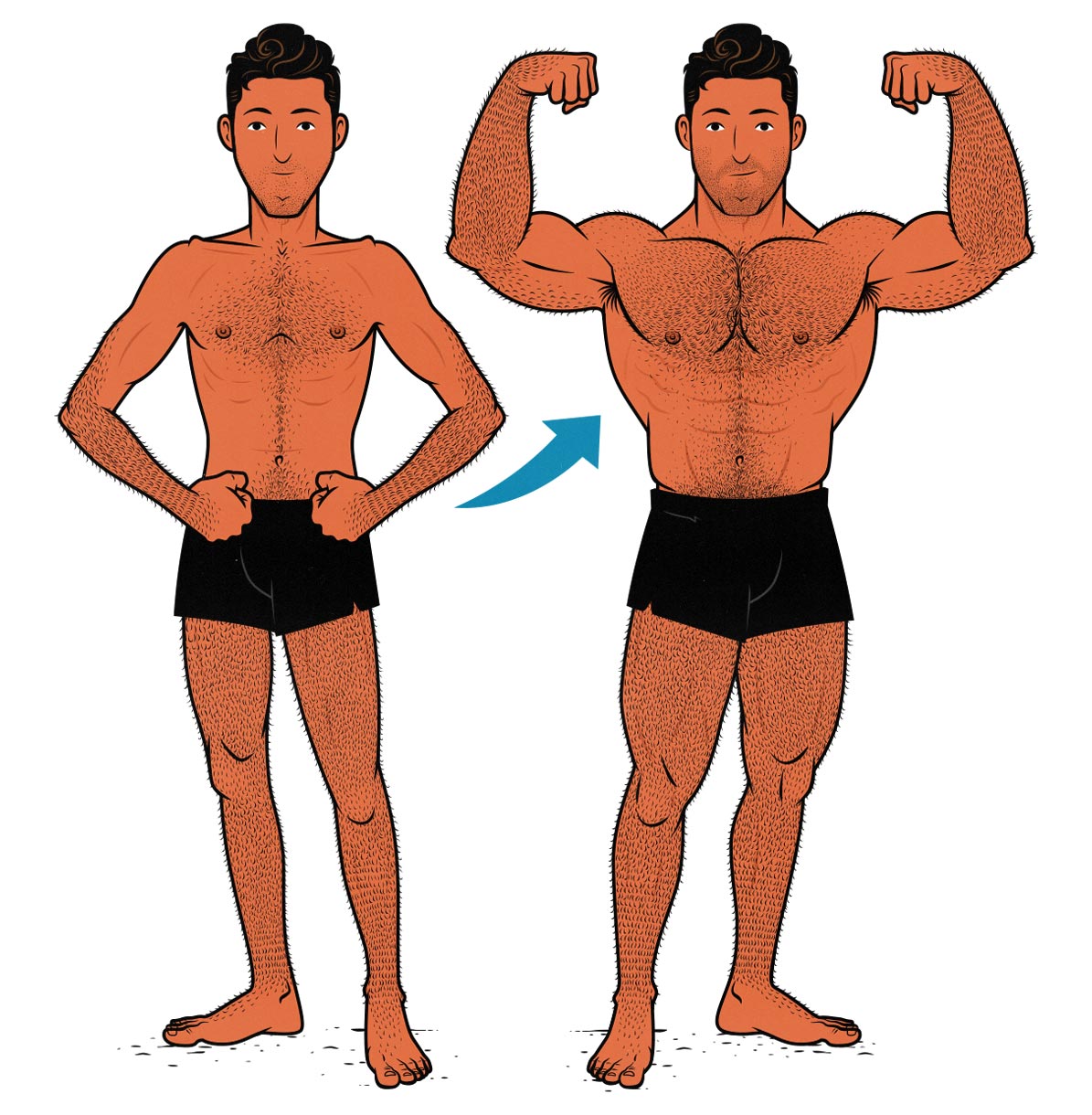
Is Bulking Dead?
Over the past few years, there have been a few studies showing that:
- If you’re skinny, lean, or already in the habit of lifting weights, then you probably need to eat in a calorie surplus to build muscle (study, study, study, study). This isn’t debated.
- The larger your calorie surplus is, the quicker you’ll gain weight and the faster you’ll build muscle, but you’ll also gain more body fat (study, study). This is the tricky part.
Researchers like Dr. Eric Helms have used those two last studies to argue that most people shouldn’t bulk aggressively. His stance is pretty reasonable and nuanced. I don’t have any issue with it at all. In fact, I consulted with him before writing this article—more on that in a moment.
However, a couple of weeks ago, someone doing our bulking program asked me about this video of Dr. Mike Israetel interviewing Dr. Eric Helms about bulking research:
It’s a good video. I recommend it. But Eric Helms argues that a large calorie surplus doesn’t give you much extra muscle growth, it just makes you fat. So, to keep your gains lean, he recommends gaining no more than 0.5% of your body weight per week.
I think that method has a couple of problems, especially for skinny people. I made a video response, but I’ll also give a written response below.
Should You Gain 0.25–0.5% of Your Body Weight Per Week?
The standard advice comes from one of Dr. Eric Helms’ studies (study). In that study, Helms argues that you should gain 0.25–0.5% of your body weight per week:
| Novice/Intermediate | Advanced | |
|---|---|---|
| Weekly Weight Gain | ~0.25–0.5 (% of body weight) | ~0.25 (% of body weight) |
| Calories | +10–20% above maintenance | +5–10% above maintenance |
| Protein | 1.6–2.2 g/kg | 1.6–2.2 g/kg |
| Fats | 0.5–1.5 g/kg | 0.5–1.5 g/kg |
| Carbs | Remaining calories (≥3–5 g/kg) | Remaining calories (≥3–5 g/kg) |
For example, if you’re a 130-pound skinny guy, that means you shouldn’t gain more than about half a pound per week. That sounds reasonable, but when I was a 130-pound skinny guy, I gained weight almost three times faster than that.
Here’s the problem: weight is used as a proxy for the size of your bone structure. It’s supposed to differentiate between 5’1 women and 6’6 guys. It’s not supposed to differentiate between one 5’9 guy who weighs 100 pounds and another who weighs 200 pounds.
Skinny people weigh less, so this formula tells us to bulk slower. That’s backwards. The less you weigh (with a given bone structure), then the more room you have on your frame for muscle growth, allowing you to build muscle faster.
So I reached out to Eric Helms, and I laid out my case, and he agreed with me. He says he’ll probably update his bulking recommendations in the next edition of his book so that they work better for skinny people:
In the third edition of my books I’ll likely acknowledge this because of this interaction and hopefully make the recs, if not quantitatively more inclusive, provide conceptual advice qualitatively to people who don’t fit them well. So thank you!
Eric Helms, PhD
I had a similar conversation with Greg Nuckols a few years ago when he asked me if I wanted to be an affiliate for his new calorie-tracking app, Macrofactor. I don’t track my calories anymore, but it can be really helpful, and the app is amazing. We have a full review here.
Macrofactor uses that same formula, calculating your rate of weight gain based on your weight. That works well on average, but it doesn’t work very well for skinny people. Fortunately, Greg Nuckols agreed and updated the app to allow for somewhat more aggressive bulking. We agreed to become affiliates (and you can get an extended free trial with the coupon code “b2b”).
I Gained 37 Pounds of Muscle With 6 Months of Bulking
The first time I bulked up was in my early twenties. I was 6’2, and my weight fluctuated between 120–130 pounds, giving me a BMI of 16.7 on a good day after a big meal. I started that bulk at 130 pounds, weighing the most I’d ever weighed. I gained twenty pounds of muscle in three months, finishing leaner than when I started:
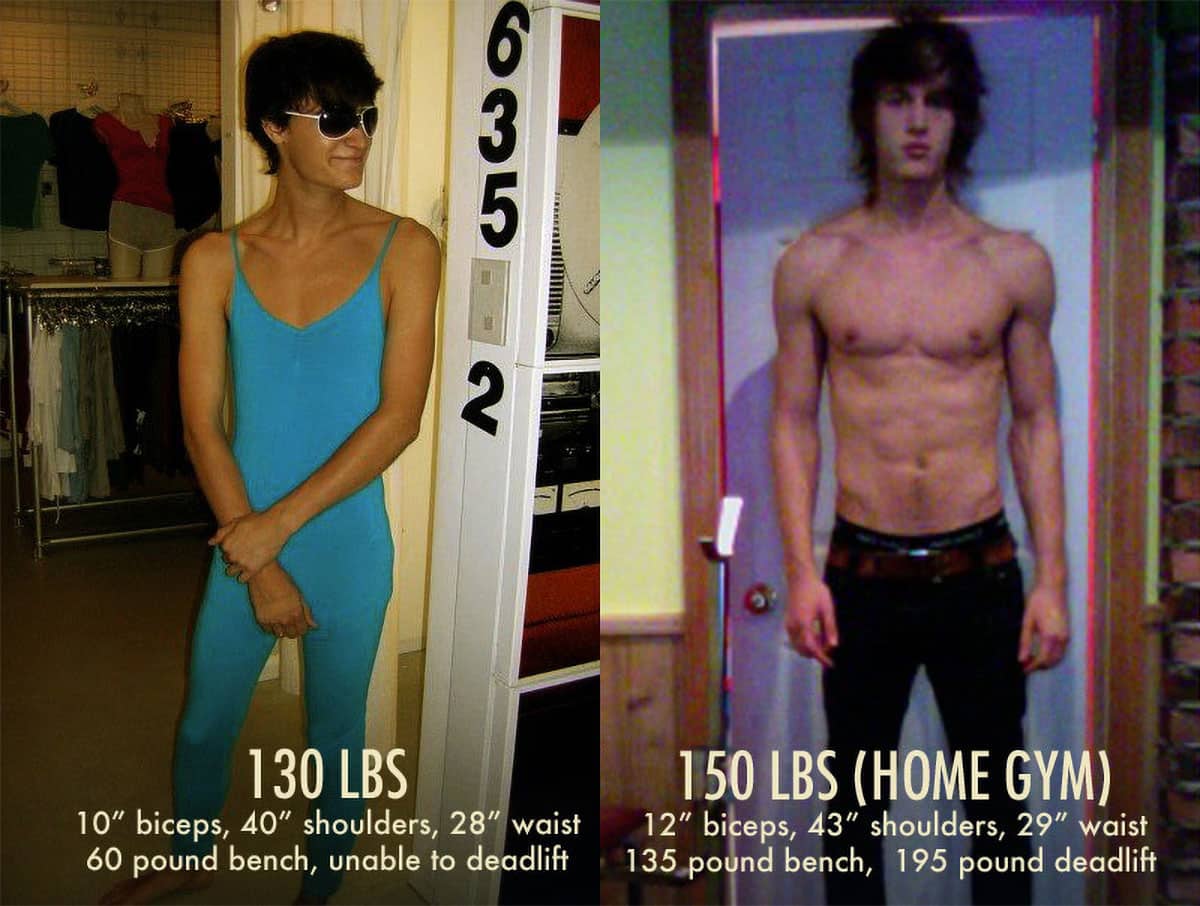
I bulked again a few months later, gaining weight even faster, gaining 25 pounds in three months. This time, I did gain fat, but not enough to notice, let alone worry about:
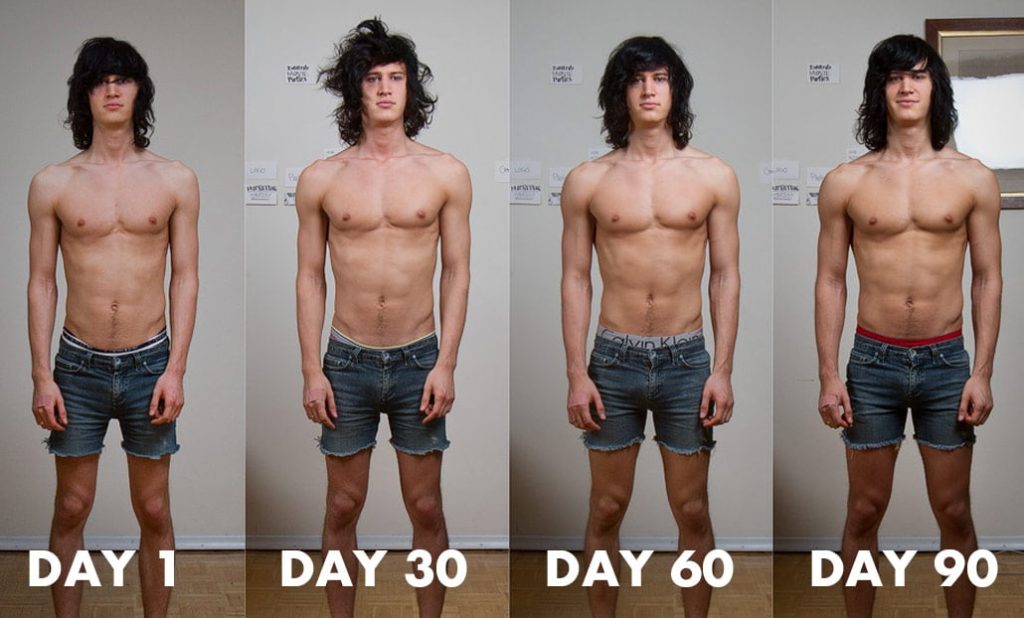
When you’re as thin as I was, you aren’t afraid of fat, fat’s afraid of you. And lo, as soon as I finished bulking, it fled my body as fast as it possibly could. It was the first time I ever tried cutting, and I didn’t have a big appetite, so I lost weight quicker than I intended to. I lost eight pounds in one month, finishing at my lowest body-fat percentage ever:
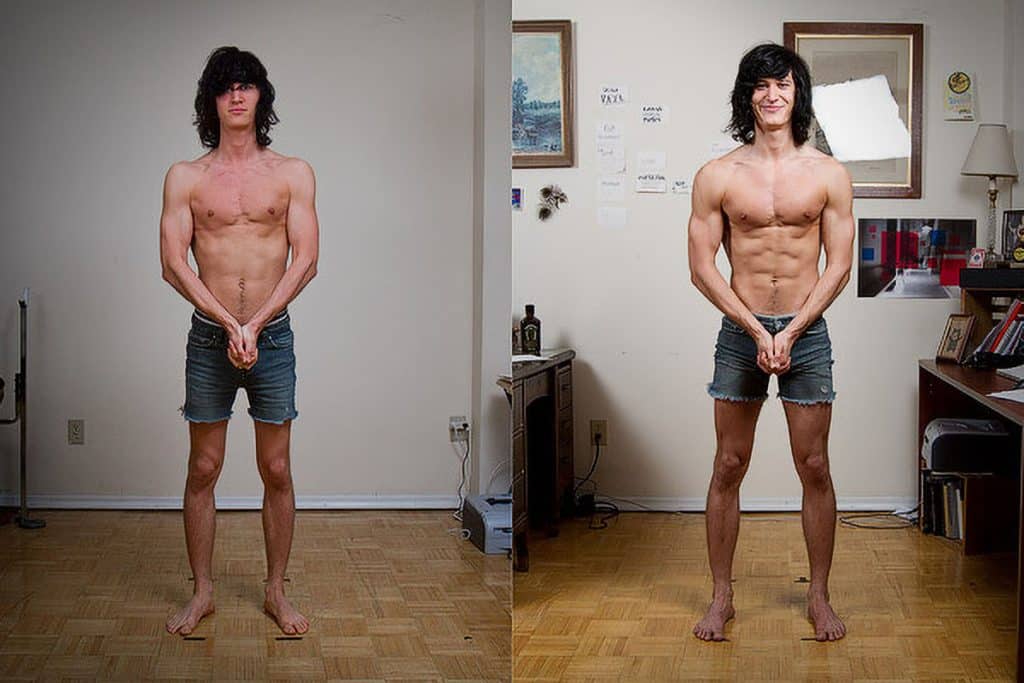
In the end, adding up the results from both of my bulks, I gained 37 pounds with six months of bulking and one month of cutting, and I was leaner than ever.
Examples of Fast, Lean Muscle Growth
There are plenty of other examples like mine. The one that had the biggest impact on me came from my roommate and business partner, Jared. I helped him bulk up, and he gained muscle even faster than I had, gaining 27 pounds in four months:
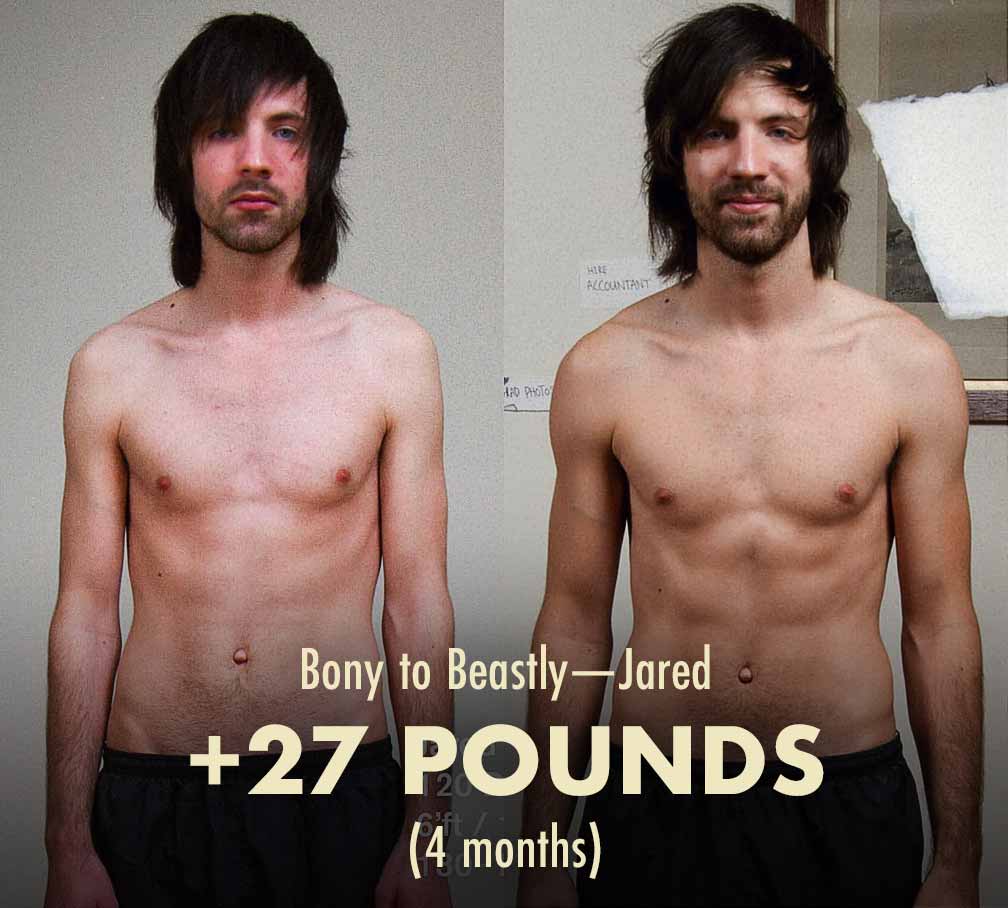
After we created Bony to Beastly, we started coaching other skinny guys, and they got similar results to ours. Here’s GK gaining 29 pounds of muscle in 5 months, finishing leaner than when he started:
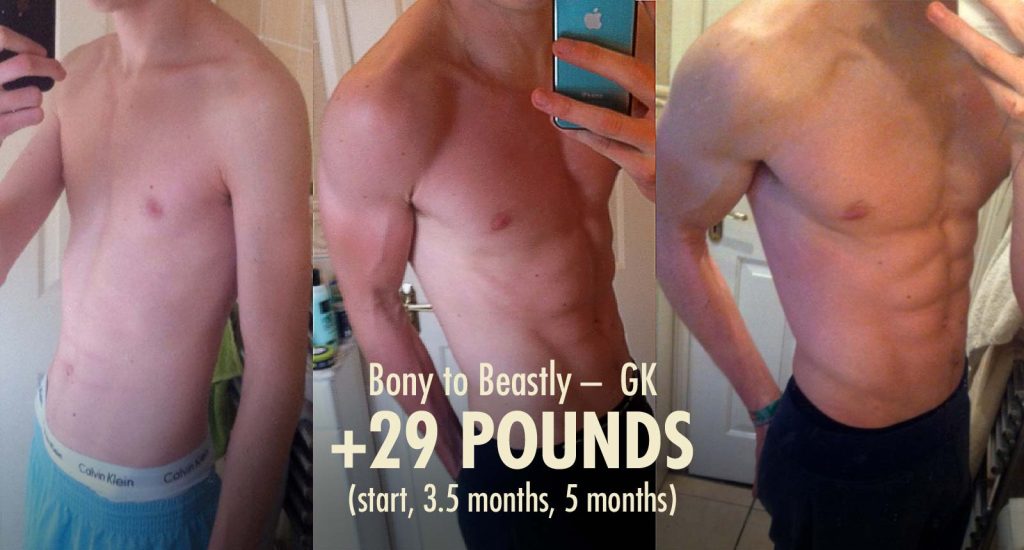
It works on our older clients, too. Here’s Eddi bulking up for his sixtieth birthday, gaining almost nineteen pounds in three months:

Here’s Matthew gaining 28 pounds in 20 weeks, finishing with better ab definition than when he started:
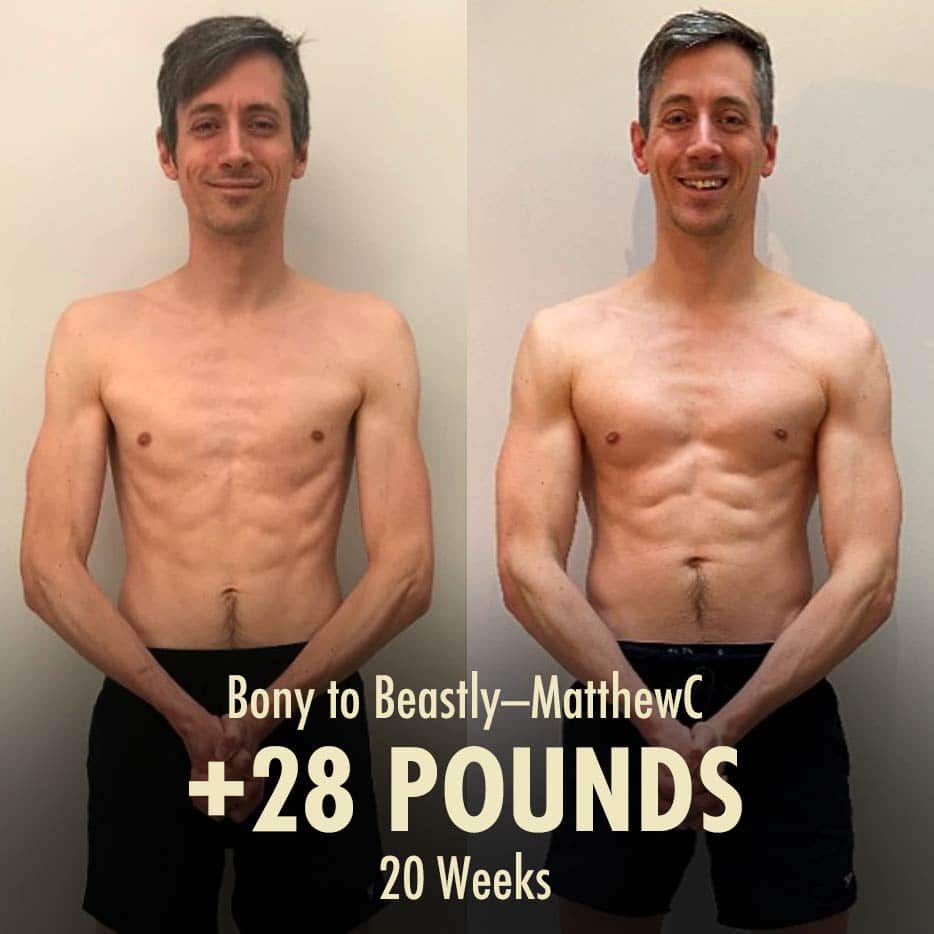
Here’s Ben bulking extremely aggressively, gaining twenty pounds in just ten weeks, abs still doing fine:

And here’s one of the most aggressive bulks I’ve ever seen. Chema gained forty pounds in five months. That’s two pounds per week for twenty weeks in a row. He did gain some fat, but he also gained a tremendous amount of muscle:
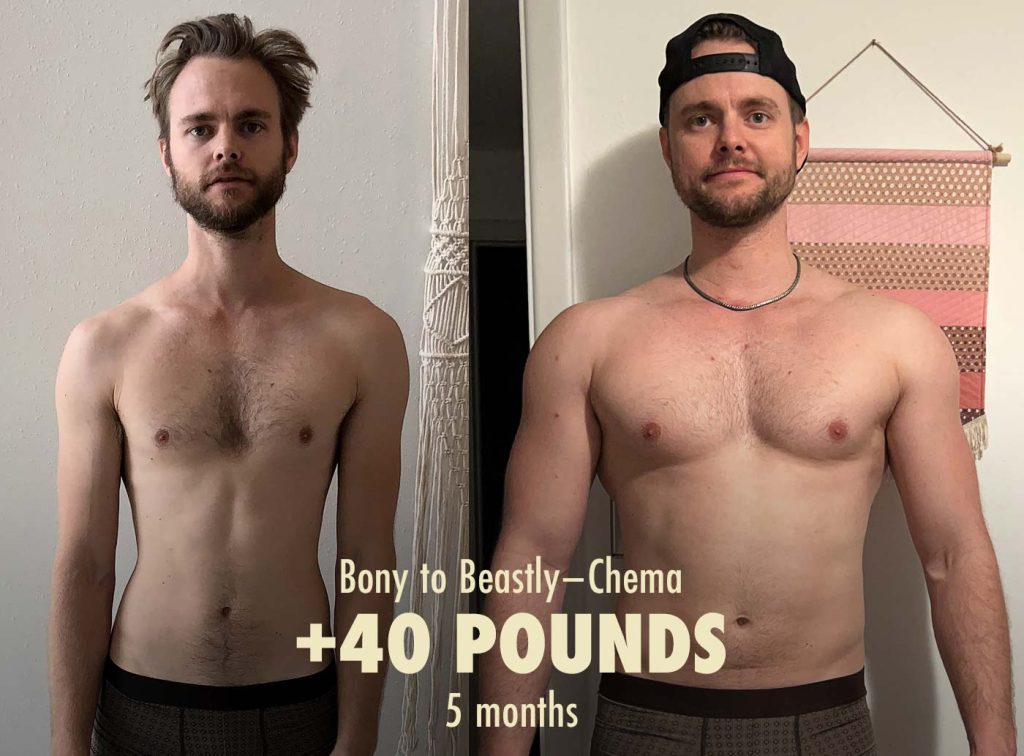
I’ve seen hundreds of these transformations. You can see more on our bulking transformation page.
We never told these guys to gain weight so quickly. We used to tell people to gain about a pound per week, at most. It’s just that our more impressive before/after photos were from guys who chose to ignore our warnings and gain weight faster. I can hardly blame them. I did the same thing.
The Famous Mass Gainer Bulking Study
There are examples of fast, lean muscle growth in the research, too. In that Mike Israetel video, Eric Helms mentioned the Rozenek study. The researchers put a bunch of new lifters on a workout program and gave them mass gainers full of thousands of calories of carbs. On average, they gained a pound of muscle per week while losing fat:
What’s interesting is that the participants weren’t even particularly skinny. This shows that even regular people can sometimes benefit from bulking at least somewhat aggressively, at least during their first couple of months of lifting weights.
If you want to know more about the mass gainers they were using, I cover this study in more detail in our article on mass gainers.
How Much Muscle Can You Gain in a Year?
There’s this idea that people can gain twenty pounds of muscle in their first year of bulking, ten in their second, five in their third, and gradually less after that (as explained here):
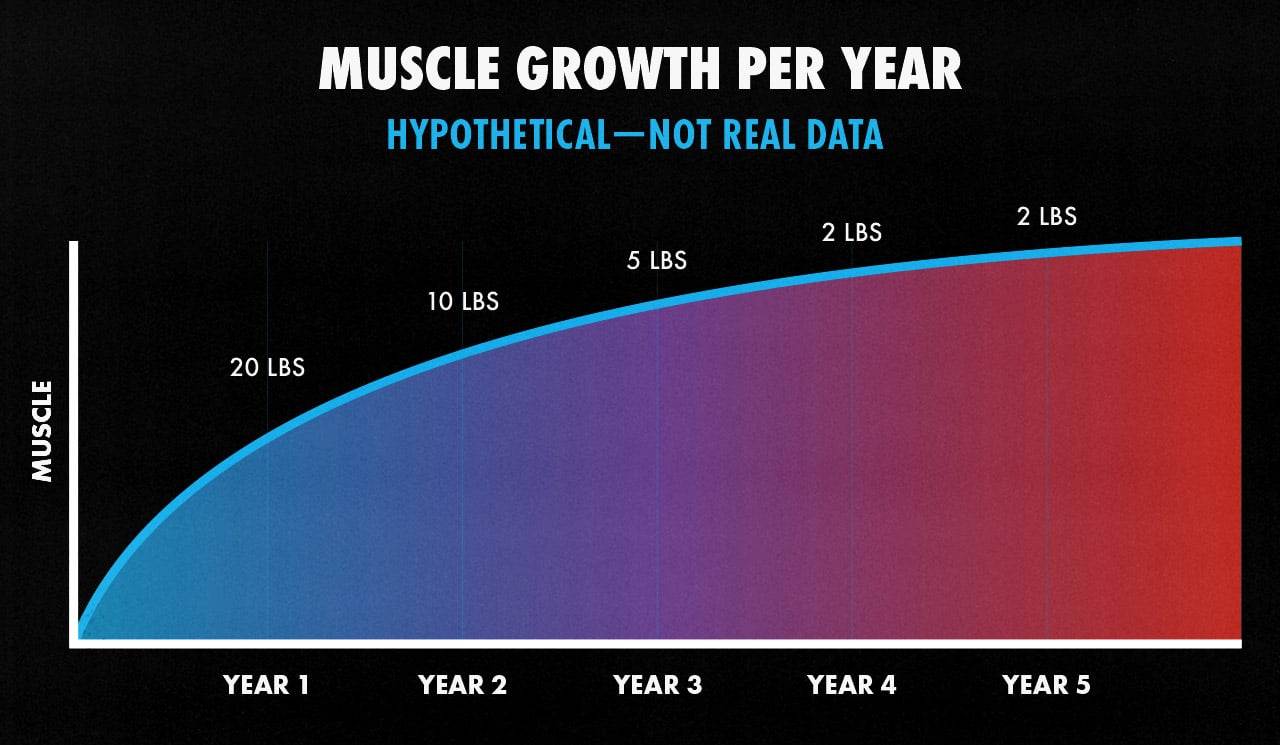
It’s such a common rule of thumb that some people consider it a hard limit, forgetting it’s just a loose heuristic. That’s where all of these misunderstandings stem from.
When you’re bulking, the idea is to line up your rate of weight gain with your predicted rate of muscle growth. So, if you think you can gain a pound of muscle per week, then you’d eat enough food to gain a pound of weight per week, hoping that most of that weight is muscle.
However, if you look at that graph, you’ll see you can only expect to gain 20 pounds in your first year. That’s less than half a pound per week. That means that if you gain a full pound per week, more than half of your gains would be fat. If that were true, it would make sense to bulk more slowly, gaining half a pound per week.
There’s a problem with the graph, though. The curve is correct. It’s true that your rate of muscle growth diminishes as you get closer to your genetic potential. But this graph is for the average person starting off with an average amount of muscle. If you’re skinny, you’re starting further back:
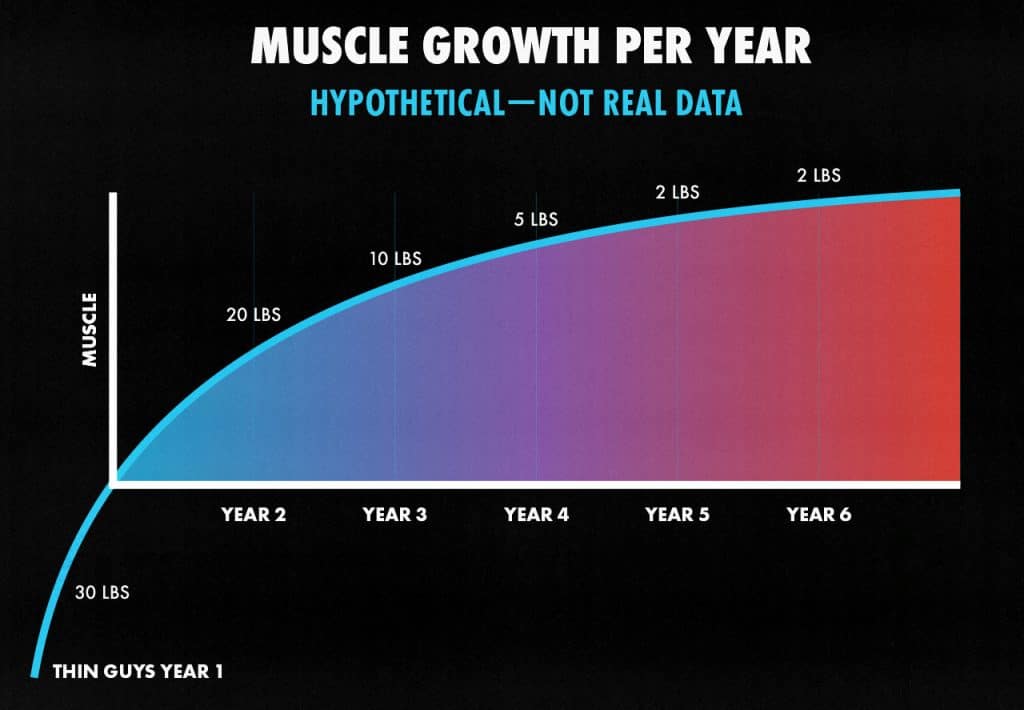
I suspect that skinny people get an extra, even more extreme round of newbie gains. I’ve seen it over and over and over again with skinny clients. I also checked to see what Dr. Eric Helms, thought. I showed him the graph, and he thinks my hunch is right:
Ok good! And I think you’re right, and that actually lines up with the data mis-applied to the p-ratio convo. With underweight people recovering from [eating very-low calorie diets] you see preferential [lean body mass] gains.”
Eric Helms, PhD
If you’re as skinny as I was, then maybe in your first year of lifting weights, you can gain 30 pounds, bringing you to the starting line. After that, maybe you can gain another 20 pounds in your second year. That’s how someone like me, who started off very skinny, was able to gain fifty pounds during my first two years (with about one year of actual bulking):
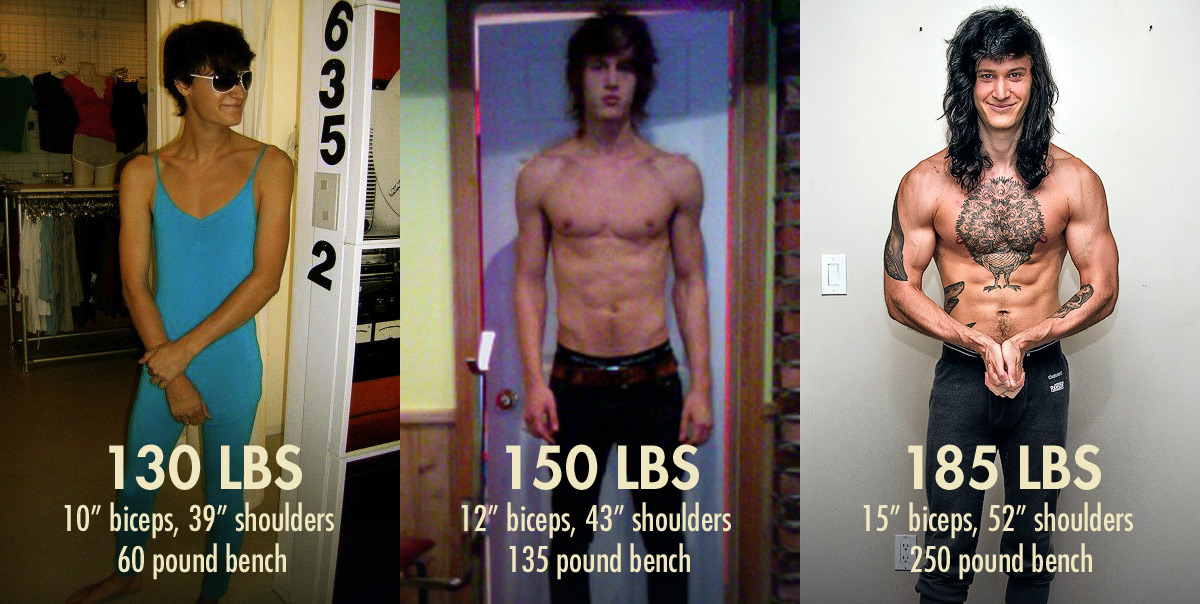
Who Should Bulk Aggressively?
Bulking definitely isn’t dead, and neither is aggressive bulking. I don’t think any credible expert actually believes that. It’s just that most of them aren’t thinking about skinny people when making their recommendations. Still, bulking aggressively is only wise under some circumstances:
- If you’re skinny or thin
- If you’re relatively new to lifting weights
- If you’re regaining lost muscle mass
- If you’re taller than average
- If you’re naturally lean
You also need a relatively strong digestive system. To gain weight fast, you need to eat and digest a huge bulking diet. That can be quite hard, especially for “hardgainers” like us. There are ways to make eating more calories easier, such as by drinking high-calorie smoothies, but it can only bring us so far. It’s still hard.
Conclusion
If someone is doing our bulking program, and they’re thin, and they’re eager to build muscle fast, and aren’t particularly afraid of gaining fat, we give them the option to bulk more aggressively, often gaining upwards of a pound per week. Then, we monitor their progress:
- If they’re gaining muscle relatively leanly, we stay the course.
- If we notice they’re gaining fat, we slow it down. And we slow it down before the extra body fat becomes a problem.
That’s how we get longer-term transformations where guys finish both bigger and leaner than when they started. We bulk up as quickly and leanly as we can. Then, if needed, we incinerate the extra fat in our Hellish metabolic furnaces:
Naturally thin people tend to be quite good at burning fat, too. Most of us don’t even need to cut. Instead, we can do a “Reverse Bulk,” where we keep lifting weights and eating well but go back to listening to our appetites. That usually gives us at least a few pounds of totally effortless fat loss.
And, of course, if you are worried about gaining fat, you can always do a lean bulk. Most people doing our programs take the middle ground, doing a classic bulk, but some bulk more aggressively, and others choose to bulk more leanly. It all depends on your circumstances and preferences.
Alright, that’s it for now. If you have any comments, drop them below. I read and answer all of them.

If you want to know all the ins and outs of building muscle, we have a free newsletter. If you want a full foundational bulking program, including a 5-month full-body workout routine, gain-easy diet guide, recipe book, and online coaching, check out our Bony to Beastly Bulking Program.
Shane Duquette is the founder of Outlift, Bony to Beastly, and Bony to Bombshell, each with millions of readers. He's a Certified Conditioning Coach (CCC), has gained 70 pounds, and has over a decade of experience helping more than 15,000 people build muscle. He also has a degree in fine arts, but those are inversely correlated with muscle growth.

